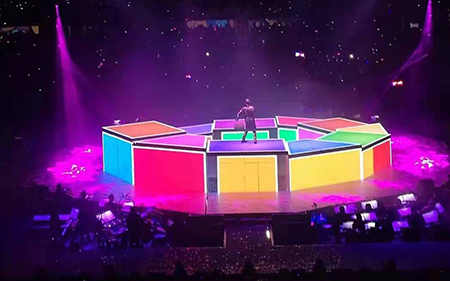Nowadays, stage rental LED screens with their brilliant colors and versatile patterns can effectively meet people's requirements for stage beauty applications, create a good stage atmosphere, and vividly demonstrate the concepts of fantasy, technology, market, and fashion, making stage rental LED screens an important part of stage aesthetics. However, the quality of stage rental LED screens is often affected by some factors. Do you know what factors affect the quality of stage rental LED screens? The following is an introduction by ONUMEN:

Factors that affect the quality of stage rental LED screens are as follows:
Brightness
LED brightness is a crucial determinant of stage rental LED screen quality. Higher LED brightness allows for a greater margin in the current used, helping save power and maintain LED stability. LEDs have different angle values, and, all other things being equal, smaller angles make LEDs brighter but reduce the screen's viewing angle. It's generally recommended to select LEDs with a 100-degree angle to ensure a sufficient viewing angle for the stage rental LED screen.
Failure rate
Since stage rental LED screens are composed of tens of thousands or even hundreds of thousands of pixels, any failure in one of the red, green, or blue LEDs will impact the overall visual quality of the screen.
Flatness
The surface flatness of an stage and indoor rental led display should be within ±1mm to prevent distortion in displayed images. Local protrusions or depressions can create blind spots in the screen's viewing angles. The quality of flatness mainly depends on the manufacturing process, and during installation, technicians need to carefully observe and ensure the flatness.
Pixel pitch
Pixel pitch has a significant impact on the clarity of stage rental LED screens. Smaller pixel pitch results in finer image display. Reducing pixel pitch requires mature technology as the core support. Looking at current trends, reducing pixel pitch is an inevitable market choice.
Gray level
Gray level refers to the number of brightness levels between darkest and brightest in a single base color's intensity on an stage rental magic LED screen. Higher gray levels lead to more color richness and vibrancy, while lower gray levels limit color variety and complexity. Improving gray levels can significantly enhance color depth and increase the number of image display layers.
Attenuation characteristics
Red, green, and blue LEDs all exhibit brightness attenuation as they age. The rate of attenuation depends on the quality of the LED chip, auxiliary materials, and packaging technology. Generally, after a 1000-hour, 20mA normal-temperature lighting test, red LEDs should have less than a 10% attenuation, and blue and green LEDs should have less than a 15% attenuation. The consistency of attenuation in red, green, and blue LEDs has a significant impact on the white balance of stage rental LED screens, thus affecting the screen's display fidelity.
Stability and safety
Stability and safety are crucial during the operation of an stage rental LED screen. The design of the cabinet is important, as an increase in component temperature due to poor heat dissipation can result in decreased image quality. Good ventilation and heat dissipation design is essential for the cabinet. This design plays a role in circuit protection, safety, dustproofing, waterproofing, and the prevention of temperature-related performance issues. Additionally, choosing a power supply based solely on low price and neglecting its performance and quality is not advisable. Power supplies perform differently under various temperature conditions in terms of stability, output voltage, and load capacity. The safety and performance of the stage rental LED screen's power supply directly affect the quality of the displayed image.
In conclusion, the factors influencing the quality of stage rental LED screens include brightness, failure rate, flatness, pixel pitch, gray level, attenuation characteristics, stability, and safety. Paying attention to these factors, along with other minor details, will help you select a high-quality stage rental LED screen.